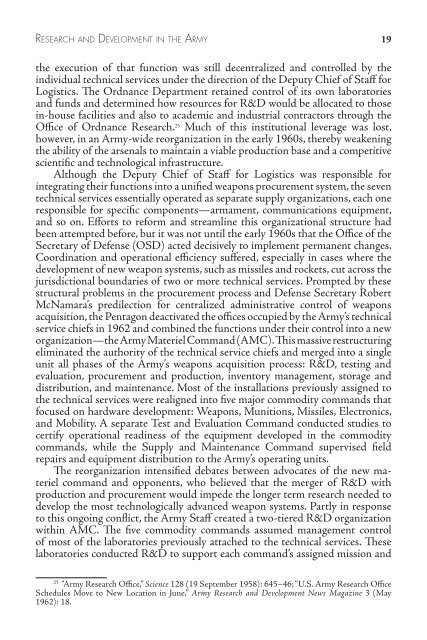To download as a PDF click here - US Army Center Of Military History
To download as a PDF click here - US Army Center Of Military History
To download as a PDF click here - US Army Center Of Military History
You also want an ePaper? Increase the reach of your titles
YUMPU automatically turns print PDFs into web optimized ePapers that Google loves.
ReseaRch a n d developmenT In T h e aR m y 19<br />
the execution of that function w<strong>as</strong> still decentralized and controlled by the<br />
individual technical services under the direction of the Deputy Chief of Staff for<br />
Logistics. The Ordnance Department retained control of its own laboratories<br />
and funds and determined how resources for R&D would be allocated to those<br />
in-house facilities and also to academic and industrial contractors through the<br />
<strong>Of</strong>fice of Ordnance Research. 25 Much of this institutional leverage w<strong>as</strong> lost,<br />
however, in an <strong>Army</strong>-wide reorganization in the early 1960s, t<strong>here</strong>by weakening<br />
the ability of the arsenals to maintain a viable production b<strong>as</strong>e and a competitive<br />
scientific and technological infr<strong>as</strong>tructure.<br />
Although the Deputy Chief of Staff for Logistics w<strong>as</strong> responsible for<br />
integrating their functions into a unified weapons procurement system, the seven<br />
technical services essentially operated <strong>as</strong> separate supply organizations, each one<br />
responsible for specific components—armament, communications equipment,<br />
and so on. Efforts to reform and streamline this organizational structure had<br />
been attempted before, but it w<strong>as</strong> not until the early 1960s that the <strong>Of</strong>fice of the<br />
Secretary of Defense (OSD) acted decisively to implement permanent changes.<br />
Coordination and operational efficiency suffered, especially in c<strong>as</strong>es w<strong>here</strong> the<br />
development of new weapon systems, such <strong>as</strong> missiles and rockets, cut across the<br />
jurisdictional boundaries of two or more technical services. Prompted by these<br />
structural problems in the procurement process and Defense Secretary Robert<br />
McNamara’s predilection for centralized administrative control of weapons<br />
acquisition, the Pentagon deactivated the offices occupied by the <strong>Army</strong>’s technical<br />
service chiefs in 1962 and combined the functions under their control into a new<br />
organization—the <strong>Army</strong> Materiel Command (AMC). This m<strong>as</strong>sive restructuring<br />
eliminated the authority of the technical service chiefs and merged into a single<br />
unit all ph<strong>as</strong>es of the <strong>Army</strong>’s weapons acquisition process: R&D, testing and<br />
evaluation, procurement and production, inventory management, storage and<br />
distribution, and maintenance. Most of the installations previously <strong>as</strong>signed to<br />
the technical services were realigned into five major commodity commands that<br />
focused on hardware development: Weapons, Munitions, Missiles, Electronics,<br />
and Mobility. A separate Test and Evaluation Command conducted studies to<br />
certify operational readiness of the equipment developed in the commodity<br />
commands, while the Supply and Maintenance Command supervised field<br />
repairs and equipment distribution to the <strong>Army</strong>’s operating units.<br />
The reorganization intensified debates between advocates of the new materiel<br />
command and opponents, who believed that the merger of R&D with<br />
production and procurement would impede the longer term research needed to<br />
develop the most technologically advanced weapon systems. Partly in response<br />
to this ongoing conflict, the <strong>Army</strong> Staff created a two-tiered R&D organization<br />
within AMC. The five commodity commands <strong>as</strong>sumed management control<br />
of most of the laboratories previously attached to the technical services. These<br />
laboratories conducted R&D to support each command’s <strong>as</strong>signed mission and<br />
25 “<strong>Army</strong> Research <strong>Of</strong>fice,” Science 128 (19 September 1958): 645–46; “U.S. <strong>Army</strong> Research <strong>Of</strong>fice<br />
Schedules Move to New Location in June,” <strong>Army</strong> Research and Development News Magazine 3 (May<br />
1962): 18.

















